Sculpted driftwood contains a history intertwined with it’s salvaged material – this is the notion that artist Guy Taplin attaches to his work. Famously producing a diverse collection of wild birds and waterfowl, this popular sculptor has produced hundreds of classic designs. His driftwood bird artwork is so popular that it is often reflected in more commercial interior designs, with the word ‘Taplinesque’ being used to describe his signature style.
 Above: a Guy Taplin sculpture which was restored in our London studio – before and after conservation treatments
Above: a Guy Taplin sculpture which was restored in our London studio – before and after conservation treatments
Today, we see many of the issues which might arise from the lightweight and porous nature of the driftwood used in these beautiful birds, as well as their vulnerability to accidental damage due to long and thin appendages. In this article we will look into the history of these contemporary works and their value, as well as tips on their care and preservation. At Fine Art Restoration Company we have also restored several Guy Taplin driftwood bird sculptures and will cover the techniques used to achieve a seamless result.
Who is Guy Taplin?
Born in London’s East End in 1939, Guy Taplin always loved birds and his enthusiasm for them began as a child. He went on to become a bird keeper at Regents Park, looking after the waterfowl and ornamental birds which inhabited the grounds. His artwork was inspired by coming across decoy ducks in antique shops; these collectible sculptures were originally used to attract other ducks to a body of water to aid hunting. Taplin made his own versions for decorative purposes and displayed them in the park, these were spotted by visitors and he had several commissions. In 1975 he started frequently carving birds, and four years later he became a full time artist with his life devoted to this craft.
 Above: a duck decoy, these floating sculptures inspired Guy Taplin when he first created his birds
Above: a duck decoy, these floating sculptures inspired Guy Taplin when he first created his birds
Taplin’s studio resides by tidal estuaries, the Blackwater and the Colne. This makes for a helpful location for gathering driftwood for his art, as well as for birdwatching. Materials used in his art often come from old boats, deteriorated jetties, and the diverse flotsum and jetsum of the tide.
How much is a Guy Taplin bird sculpture worth?
When Taplin first sold his art in the 1970s his sculptures went for around £15. Today they regularly sell for between £3000 and £30,000. In 2013 a collection of 61 sculptures by Taplin went on sale for over £500,000 collectively. This included a piece entitled ‘Twenty Scarlet Ibis’ with a sale price of £32,500 and ‘Twenty One Flying Sanderling’ for £28,500.
 Above: the artist salvages driftwood from the Thames estuaries, where many wild birds provide inspiration
Above: the artist salvages driftwood from the Thames estuaries, where many wild birds provide inspiration
How to care for a driftwood sculpture
Taplin’s signature style involves not only a vulnerable material, but long and slim elements which can be easily knocked and damaged. This may occur as a result of a household accident, or during packaging, cleaning, storage, or transport when the weak areas may be under pressure. As the sculptures are wooden, it may be a misconception that they are fairly sturdy, however these pieces require a great deal of care and attention to prevent breakages.
Keep these sculptures away from everyday activities or busy areas, if possible. They should be set back from any walkways and if possible kept away from bright UV lighting (such as a window) to prevent the fading of any paint or coloured elements. It is also best to avoid areas above radiators or doors to lessen the fluctuation of temperature.
 Above: driftwood is a common material found in modern sculptures, these can be placed indoors or outdoors but will require care to prevent decay
Above: driftwood is a common material found in modern sculptures, these can be placed indoors or outdoors but will require care to prevent decay
Driftwood and salvaged materials may themselves be inherently weakened as they were picked up already in a state of mild or substantial natural decay. Although the wood has been thoroughly dried, it may pick up on moisture in the atmosphere from high humidity and any unsealed areas may attract mould spores and rot. Wood such as this needs a balanced environment, as dry air can make the structure brittle by contrast. Constant fluctuations in humidity can cause warping in the wood as it subtly expands and contracts – this may also fracture and crack the material under strain, including the paint layer. A controlled and well-maintained atmosphere will keep the sculpture safe from deterioration, a recommended humidity is around 40% and a temperature of around 20 degrees celsius.
When it comes to the cleaning of a driftwood sculpture, such as those by Guy Taplin, it is not advisable to use household cleaners and chemicals. A light dusting without any applied pressure is the best way to reduce any build up of contaminants, whilst a deeper clean should be conducted by a professional conservator with tailored methods.
 Above: driftwood is also at high risk of woodworm or other pests eating and burrowing into the surface of the work
Above: driftwood is also at high risk of woodworm or other pests eating and burrowing into the surface of the work
Amateur repairs may have also led to damage over time, this includes the use of household adhesives such as superglue and sticky tape, which have acidic elements. This will lead to a yellowing and a decay of the affected areas, ultimately creating more damage than they hoped to fix originally. Luckily, our conservators are able to fully remove this discolouration and the acids, before professionally restoring the broken pieces with conservation-appropriate solutions.
Restoring a driftwood bird sculpture by Guy Taplin
We have restored several pieces by Guy Taplin in our studio, our expert conservators are trained in the materials found within these popular sculptures and can achieve seamless results. An example of this is a restoration completed in 2020, a typical driftwood bird had been damaged in transit and required restoration work to lessen further deterioration and bring back the original design.
 Above: the damaged Guy Taplin sculpture when it first arrived at our studio
Above: the damaged Guy Taplin sculpture when it first arrived at our studio
The sculpture was covered in a layer of paint and gesso, these layers were now exposed due to the breakages and at high risk of further deterioration and loss without treatment. Although our client was able to save some pieces of the broken gesso layer, many had been lost entirely. The bird had a loosened wing and further areas of instability.
Above: our ceramics conservator filling the broken areas on a Guy Taplin sculpture to stabilise it and prevent further flaking
To begin the restoration, the sculpture had its surface cleaned of any contaminants and dust. The loose areas were then repositioned and strengthened to return them to their original state. The lifting gesso layer was consolidated and stabilised, ensuring that the paint was no longer at risk of falling away. The loose pieces of gesso were also re-applied with conservation solutions and any missing parts were filled with an appropriate texture and then colour-matched to the rest of the sculpture.
 Above: close ups of the broken gesso and damage to the sculpture
Above: close ups of the broken gesso and damage to the sculpture
Our conservators work with methods tied to historical and artistic integrity, this means that every decision made in the process is to protect the artwork as well as ensure it is not edited or interfered with. A conservation approach is important when it comes to artwork by such a renowned artist, as the value of the piece is tied to their craftsmanship, which our team will never alter. This means that any historic wear and tear, or the natural effects of the driftwood, will not be changed or repaired where it is not required or is in fact part of the original creation and nature of the piece.
 Above: the sculpture before and after restoration by our conservator
Above: the sculpture before and after restoration by our conservator
How can we help?
If you have a Guy Taplin driftwood bird sculpture which is in need of restoration or specialist care, please do not hesitate to contact our team. We can also help with any other form of driftwood art, including breakages, mould, or deterioration.
To get in touch please email us via [email protected] or call 0207 112 7576.

 Above: a Guy Taplin sculpture which was restored in our London studio – before and after conservation treatments
Above: a Guy Taplin sculpture which was restored in our London studio – before and after conservation treatments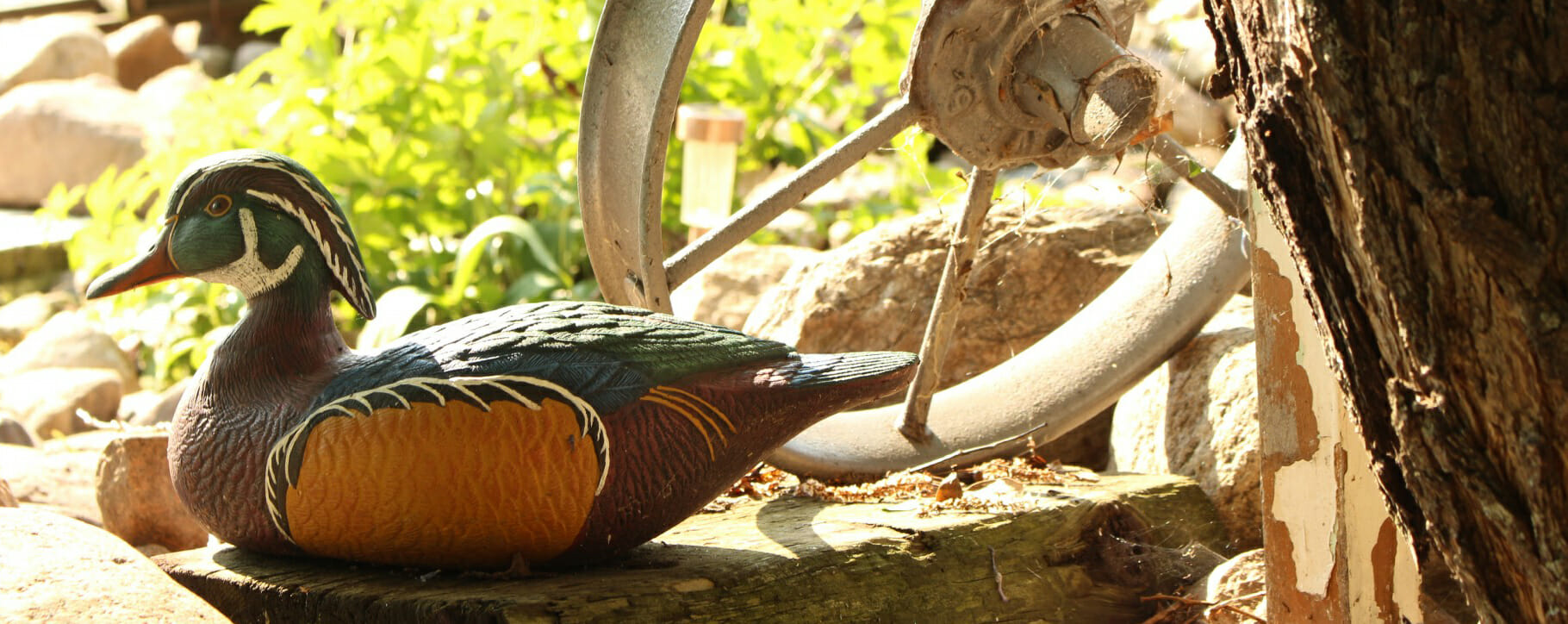 Above: a duck decoy, these floating sculptures inspired Guy Taplin when he first created his birds
Above: a duck decoy, these floating sculptures inspired Guy Taplin when he first created his birds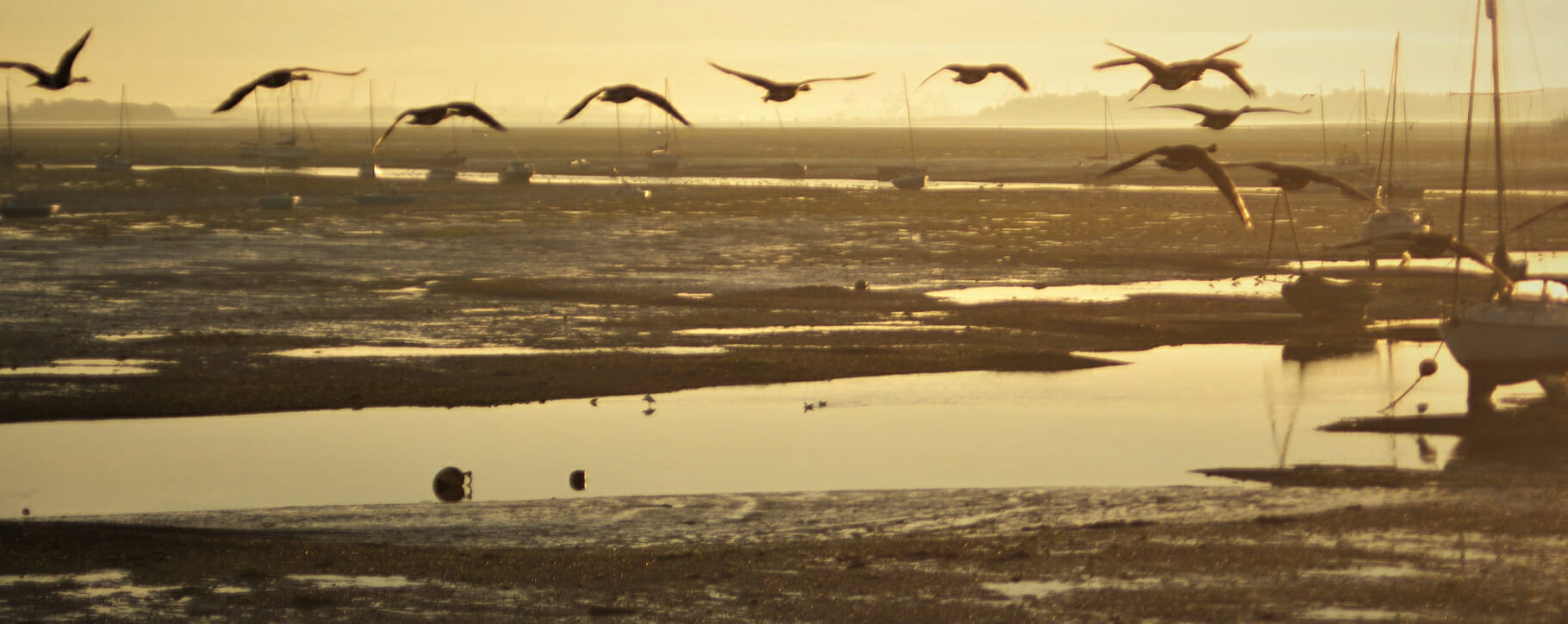 Above: the artist salvages driftwood from the Thames estuaries, where many wild birds provide inspiration
Above: the artist salvages driftwood from the Thames estuaries, where many wild birds provide inspiration 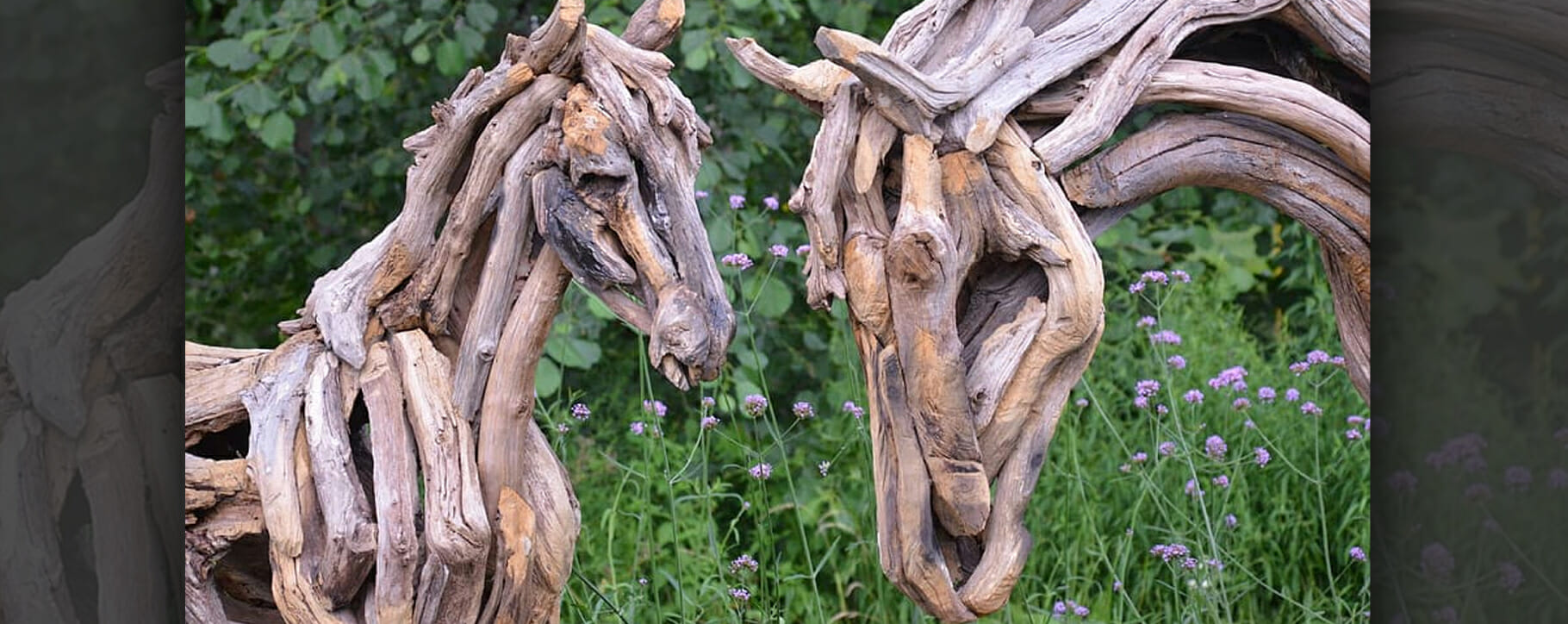 Above: driftwood is a common material found in modern sculptures, these can be placed indoors or outdoors but will require care to prevent decay
Above: driftwood is a common material found in modern sculptures, these can be placed indoors or outdoors but will require care to prevent decay 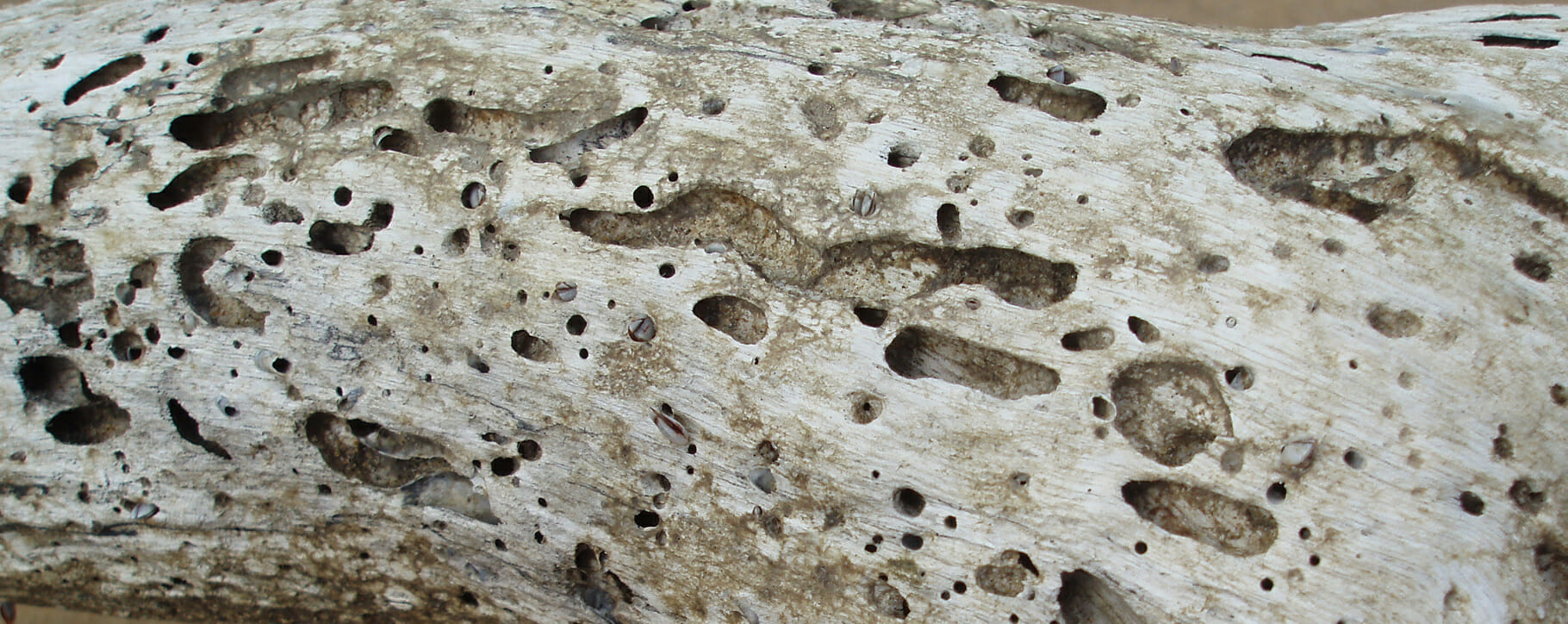 Above: driftwood is also at high risk of woodworm or other pests eating and burrowing into the surface of the work
Above: driftwood is also at high risk of woodworm or other pests eating and burrowing into the surface of the work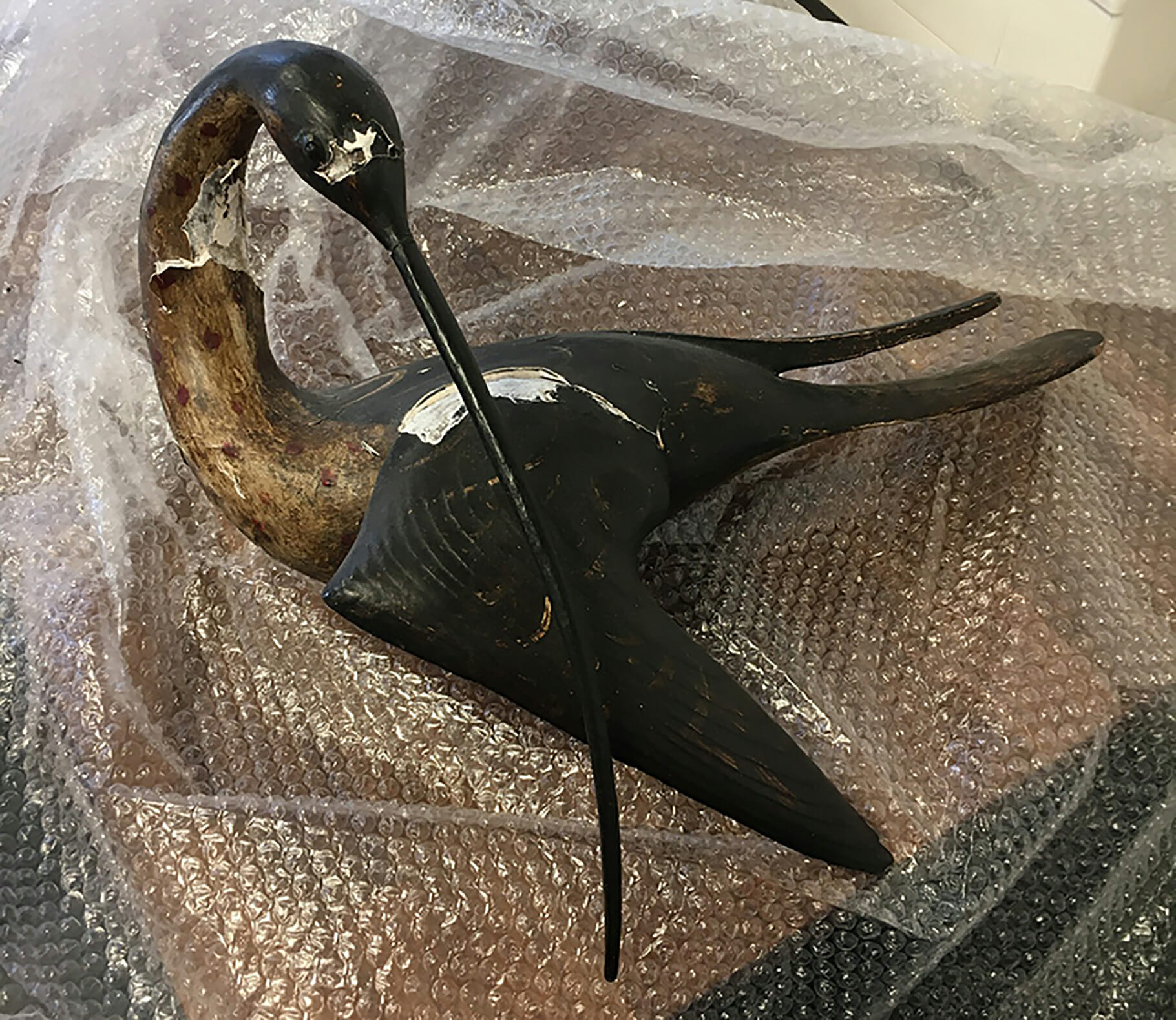 Above: the damaged Guy Taplin sculpture when it first arrived at our studio
Above: the damaged Guy Taplin sculpture when it first arrived at our studio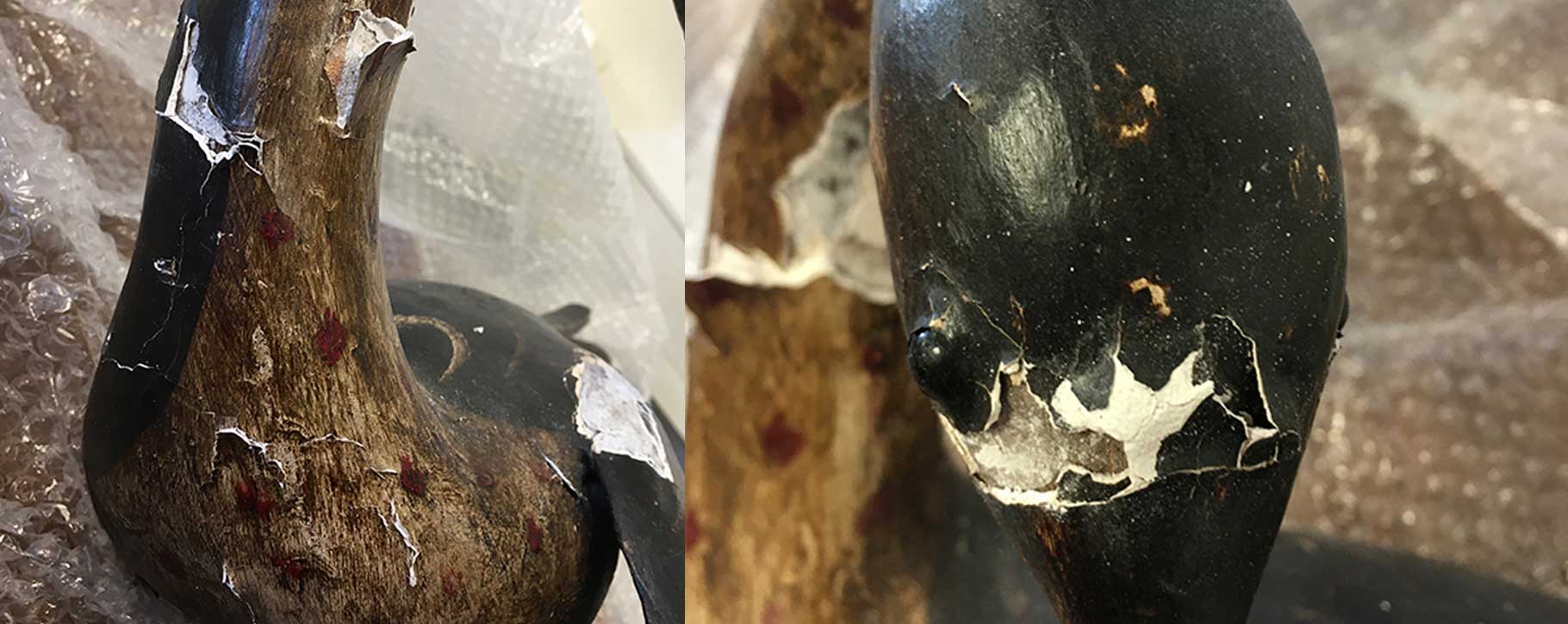 Above: close ups of the broken gesso and damage to the sculpture
Above: close ups of the broken gesso and damage to the sculpture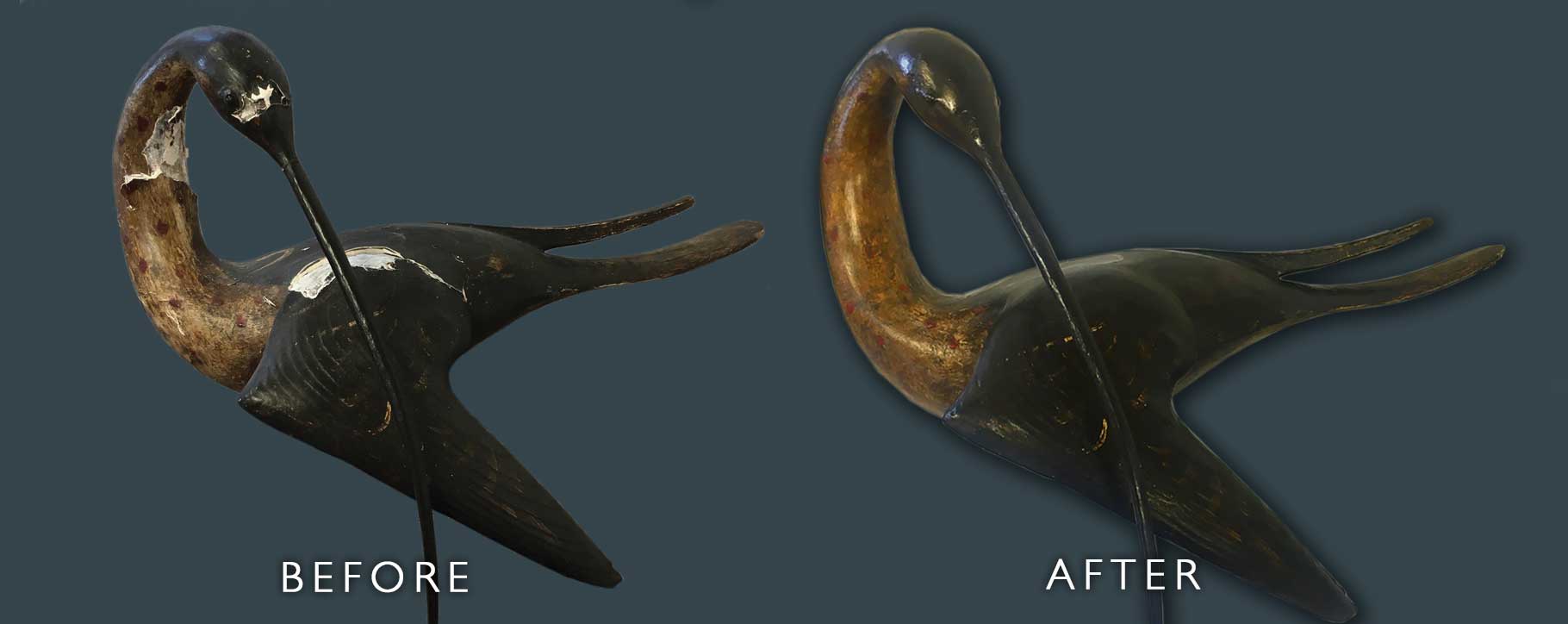 Above: the sculpture before and after restoration by our conservator
Above: the sculpture before and after restoration by our conservator




